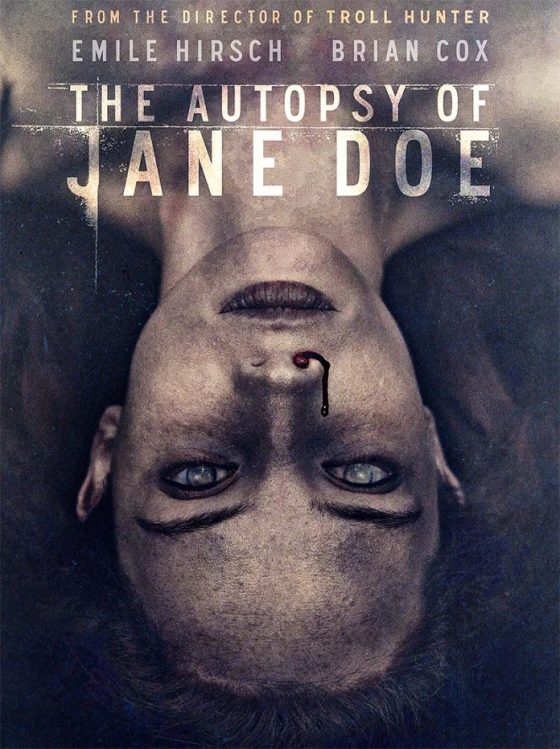 As The Autopsy of Jane Doe unfolded, I couldn’t help thinking of Kristy Guevara-Flanagan’s short film, What Happened to Her (USA, 2016). In a review for the Australian arts journal RealTime, I wrote of Guevara-Flanagan’s film:
As The Autopsy of Jane Doe unfolded, I couldn’t help thinking of Kristy Guevara-Flanagan’s short film, What Happened to Her (USA, 2016). In a review for the Australian arts journal RealTime, I wrote of Guevara-Flanagan’s film:
‘What Happened to Her is a startling assemblage of film and TV clips demonstrating the sheer proliferation of nubile dead bodies on our screens. There’s no identification of individual titles, but the clips derive from serious, artistic drama (Twin Peaks, True Detective) as well as forgettable forensic crime shows. On her back or face down, in the sand, in the water or exposed to the gaze of some sad-eyed (usually male) detective in the morgue, “the body” is allowed to speak here through a quiet voiceover, as an actor relays her experience playing the naked corpse while a seemingly inexhaustible collection of examples is displayed.
To uncanny effect, she details what it’s like to be told to strip naked and float face-down in water playing dead; to have bruises painted on you by a sleazy make-up artist; to feel vulnerable in front of all-male crews; to embody a real victim on a crime show. The voice prompts thought about all the women – fictional and real – whose murders have become an entertainment fetish.’
The Autopsy of Jane Doe (André Øvredal, US, 2016) opens, familiarly enough, on a crime scene; a couple have been brutally killed in their home. The house’s basement yields a third corpse – that of a young woman with no known connection to the household she has been buried beneath. Jane Doe emerges from the dirt like an alabaster statue, not externally mutilated like the couple upstairs, but on first impression indistinguishable from any one of the bodies flashed onscreen in What Happened to Her? She is taken to the local coroner’s office, a family operation run by father and son team Tommy and Austin Slennett (Brian Cox and Emile Hirsch).
Contrary to what some might expect, the initial impression of the mortuary is of convivial business-as-usual. Classic rock blasts on the stereo as the Slennetts hack away at a charred corpse, plopping internal organs onto the scales and snapping polaroids of the process, the film intercutting between charred flesh, warm wood panelling and photo pinboard.
Into this happy, well-regulated workplace comes the anomalous body of Jane Doe.
An autopsy is typically carried out to find the cause of death; to cut the body open in search of an answer. An act of detection, it seeks to bring order to chaos through the solution of a mystery. This film initially follows the structure of the autopsy, which is essentially a detective story, investigating a mystery (the body of Jane Doe) in order to arrive at a (re)solution. But this is horror, and while some horror films might eventually arrive at a cathartic resolution, their core impetus is to tip order into chaos.
The body of Jane Doe shows no sign of decomposition or rigor, and (unusually for a corpse) bleeds copiously. In Christian belief, an incorrupt body can signify sanctity – or its opposite, as in vampire lore. Whether saintly or demonic, an incorrupt body wields power. As the Slennetts begin their ministrations to the immobile body of Jane Doe, the world around them starts to warp and fracture. “One thing’s for sure,” a jaunty voice on the radio says, “You’re not going anywhere.”
It’s not easy to render an immobile body actively terrifying. What creates dread in The Autopsy of Jane Doe is the strange series of surprises that Jane Doe’s opened-up body reveals, while the Slennetts are increasingly plagued by terrors both psychological and visceral. Is this a case of a haunted morgue, or is it the minds of those who would breach Jane Doe’s secrets that have been possessed?
The Autopsy of Jane Doe pursues a standard horror movie trajectory, but it also makes an intriguing lateral comment about violence against women. Like What Happened To Her, it draws critical attention to the aestheticised corpse of a young woman; but unlike the screen works Guevara-Flanagan critiques in her documentary, Jane Doe transforms this ultimate symbol of objectification into something with devastating agency.
Additional links
Interview with Olwen Kelly on techniques she used for playing Jane Doe
What Happened To Her trailer
Faculty of Horror podcast discussing The Autopsy of Jane Doe